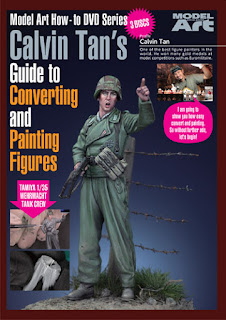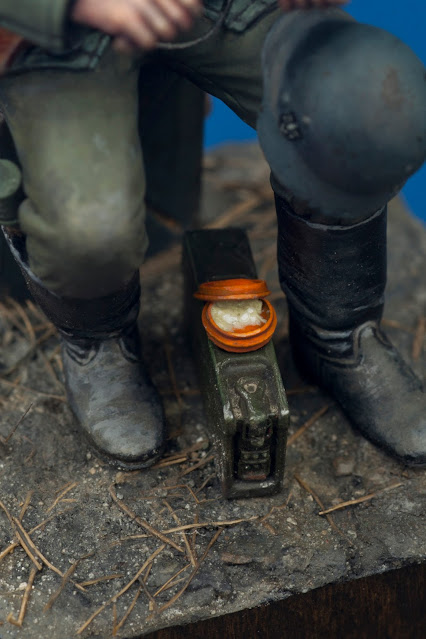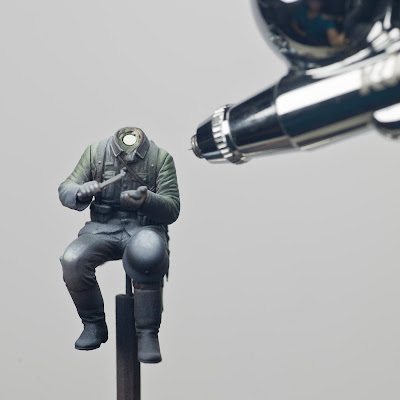Saturday 27 November 2021
Labels:
Tamiya,
Tamiya - German Soldiers at Rest
A short preview of a vignette with all four figures from the Soldiers at Rest set titled The Breaking Bread/Das Brot brechen. The setting is composed with various accessories like the piano, the garden fence, hessian bags and bottle crates from MiniArt Model and the abandoned cart from MB Model.
Cheers,
Calvin
Thursday 18 November 2021
Verpflegungspause, Unteroffizier, Großdeutschland 1942
All done on this conversion based on the seating figure from Tamiya's German Soldier's at Rest set. It is painted with AK Interactive Gen 3 paints specifically from my signature set for German Uniforms. And now it is my turn to get a refreshment break :)
Cheers,
Calvin
Tuesday 16 November 2021
Unteroffizier, Großdeutschland 1942 - Painting the Field Grey Tunic - Part 2
In this installment, I will reveal my process of rendering the tunic with a round brush. The brush sizes are 2 for larger areas and 0 for the fine details. I began by painting the highlights on the tunic with a lighter tone created by increasing the proportion of grey green in the base colour mixture. This colour was applied to reinforce the lighter areas revealed from the under painting.
After applying the first highlights, I proceeded to accentuate the shadows and recesses of the uniform with a wash of Rubber Black. I diluted the paint with one part paint to 4 parts AK acrylic thinner instead of water. Unlike water, the AK thinner is more fluid and spreads more evenly; furthermore it prevents the paint from beading and scattering throughout the model's surface.
With the shadow areas darken from the wash, I proceeded to apply a second round of highlights using just Grey Green. This also helps to repair any staining effects caused by the wash onto the previously highlighted areas.
Lastly a third round of highlights colour is applied exclusively to the highpoints with a paint mixture created by adding Flesh Highlight to the base colour.
Once the general tones are applied, I proceeded to outline the pockets and seams of the tunic using a colour mixture of Rubber Black and Dark Prussian Blue. The combination of these two colours create a dark shade that compliments rather nicely with the field grey base colour.
This dark shade is carefully painted into the recessed areas of the tunic with a 0 sized brush.
The collar is undercoated with Black and highlighted with Black Green.
The collar liner (Kragenbinde) and collar piping are undercoated with a colour mixture of White Grey and Grimy Grey.
The painting of the collar liner is further refined and the knife is undercoated with Basalt Grey. The piece of toast on the left hand is given an undercoat of Grimy Grey.
That is all for now. I will be compiling the remainder of the painting process as part of a journal for publication.
Calvin
Thursday 11 November 2021
Unteroffizier, Großdeutschland 1942 - Painting the Field Grey Tunic - Part 1
Labels:
AK Interactive Calvin Tan Signature Set,
Tamiya,
Tamiya - German Soldiers at Rest
Posted by
Calvin Tan
at
14:46
In this instalment, I will reveal my process of utilizing my signature set of colours from AK Interactive to render a Field Grey tunic.
To create a greenish-blue tone of field grey typical in most early war tunics, I will concoct a mixture of Field Grey Base #1, Grey Green and Dark Prussian Blue. Take caution to add only a modicum of Dark Prussian Blue as it is extremely overpowering.
The colours were mixed on a metal surface and the mixture was allowed to dry. Once dried, I added Mr Colour Leveling Thinner 400 to dissolve the paint, rendering it usable for airbrushing.
A flat brush was used to draw the paint from the metal surface and transferred to the airbrush. The dilution rate is a 1:3 paint to thinner ratio.
The high dilution of paint was necessary for two reasons; firstly to allow a smoother discharge of paint from the airbrush nozzle and second being that I only needed a thin veil of paint to cover the surface so that the effects of the underpainting can peep through.
Truth be told, with the exception of Tamiya acrylics, I have never attained good results airbrushing with acrylic paints until most recently using the "Lazarus" method. This opens new possibilities as one could now "resurrect" dried up acrylic paints and reuse them as lacquer-based paint. If you are still sceptical about the results, just look at the following photos and you can see that it boasts a smooth and matt finish.
That is all for now. In the next instalment, I will cover the shading and highlighting of the figure using the brush.
Cheers,
Calvin
Tuesday 9 November 2021
Unteroffizier, Großdeutschland 1942 - Painting the Face
In this instalment, I will briefly describe the painting of the face using AK Interactive's Gen 3 acrylics Flesh and Skin set. This six-colour paint set provides a convenient solution for the average military modeler to render a face or skin tones without too much hassle. Truth be told I usually prefer to mix my own flesh tones instead of using ready pre-mixed ones, but since a sample was supplied to me by the good people of AK Interactive I thought that might as well give it a go.
The only shortcoming with this set is that it does come with any instructions on how to apply the colours and therefore what I am about to present is my take on how to use this set of colours. For more information on my technique for painting the face, do check out my DVD available HERE.
In my previous post, an underpainting was applied to the figure using Grey White to bring out the mid tones and highlights. The key feature of this technique is to allow the underlying white base to provide the luminosity and the overpainting to provide the colour; maintaining the saturation of the colour. Base Flesh was repeatedly applied in translucent layers to gradually deepen the areas representing the mid tones (the cloudy grey areas). I was careful to avoid to getting Base Flesh over the bright highlights as it will diminish the luminosity of the highlight colour that comes next.
Light Flesh is applied over the highlight areas. Likewise I avoided getting light flesh into the areas painted with Base Flesh as it will cause it to appear chalky.
Highlight Flesh is applied to the higher points of the face to enhance the appearance of the facial features.
Dark Shadow Flesh is applied to a deeper recesses of the face to deepen the shadows as well as the lips.
Once again, Highlight flesh is used again to refine the highlights on the face and paint the white of the eyes.
Paint the eyes with a dab of Dark Prussian Blue.
Paint the eye brows with Rubber Black.
Add a little dash Dark Shadow Flesh to the deepest recesses of the face.
Finally, highlighting the lips with a colour mixture of Dark Shadow Flesh and Base Flesh.
The completed result from this painting session.
Next up, the uniform.....
Cheers,
Calvin
Saturday 6 November 2021
Unteroffizier, Großdeutschland 1942 - Underpainting
Labels:
AK Interactive Calvin Tan Signature Set,
Tamiya,
Tamiya - German Soldiers at Rest,
Tamiya - Wehrmacht Tank Crew Set
Posted by
Calvin Tan
at
10:31
The timing could not be more perfect as I commence on the painting of this figure using my signature set of colours composed for painting WWII German Uniforms by AK Interactive.
The figure is primed using Mr Mahogany Surfacer 1000 from Mr Hobby as I wanted to work with a warmer tone as a ground colour.
The darker areas are airbrushed with black to simulate the cool tone of the shadows.
A light mist of AK 11003 White Grey was applied to simulate the lightfall. This process allows the areas for highlighting to be identified and more importantly improves the luminosity of the base colours.
AK 11003 White Grey was thinned with water to a milk-like consistency and successively applied in thin layers to strengthen the highlights. In traditional painting, this technique is referred to as underpainting and it has been pioneered by Titian during the High Renaissance.
In my next post, I will briefly cover the painting of the face so stay tuned!
Cheers,
Calvin
Subscribe to:
Posts (Atom)
































































